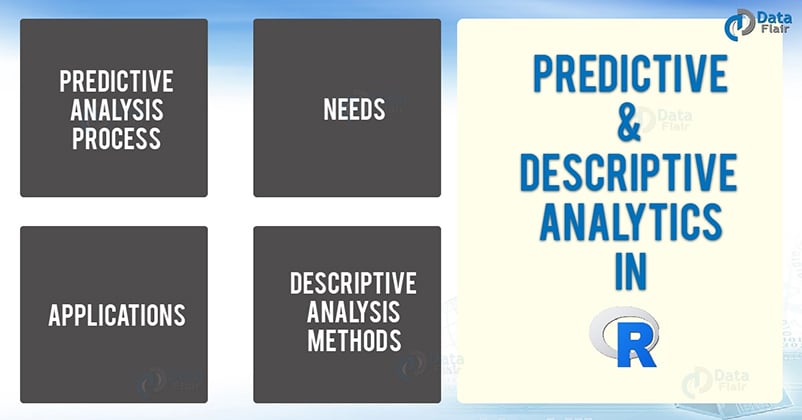Predictive and Descriptive Analytics in R – Grasp the entire concept thoroughly!
FREE Online Courses: Elevate Skills, Zero Cost. Enroll Now!
This article will provide you with detailed knowledge of R predictive and descriptive analytics.
After completion of this tutorial, you will fully understand:
- Predictive Analysis Process
- Need for Predictive Analysis
- Applications of Predictive Analytics
- Descriptive Analysis Methods
- Case Study for Churn Prevention
Let’s quickly start.
R Predictive and Descriptive Analytics Introduction
Let’s first discuss predictive analytics in R along with their process and applications.
What is Predictive Analytics in R?
Predictive analytics is the branch of advanced analysis. It is used to make predictions about unknown future events. The predictive analysis contains data collection, statistics, and deployment. It uses many techniques from data mining, statistics, machine learning and analyses current data to make predictions about the future. It also allows business users to create predictive intelligence.
Become a Machine Learning expert by completing 80+ Free Machine Learning Tutorials
1. Predictive Analysis Process
Here we will discuss the complete process of it and will learn about all the points individually.
- Define Project – Project definition involves laying out the outcomes, describing the objectives and delivering results.
- Data Collection – For predictive analysis, it collects data from different sources for analysis. Thus, it provides a complete view of customer interactions.
- Data Analysis – It is the process of cleaning, transforming, inspecting and modeling data.
- Statistics – This process enables to confirm the assumptions. Hence, it uses the assumption to test using a statistical model.
- Modeling – An accurate predictive model about future is created using predictive modeling. Furthermore, we can choose a model that is better optimized and qualified.
- Deployment – In deployment, the analytical results are implemented to strengthen the process of decision making.
- Model Monitoring – To ensure that it is providing an expected result, we have to manage the model.
2. Why we need Predictive Analysis?
- Secure a competitive Stronghold – It helps you to play with your competitors’ weaknesses and the company’s strengths. Hence, it allows you to check the actions of consumers and your competitors’ marketing and sales.
- Do more than evaluating the past – Employee analysis helps to check your company details. It will summarise past failure or success. Therefore, the most important thing is that predictive analysis helps in learning from past experiences.
- Maintain business integrity by managing fraud – First of all, fraud investigators can look into only a set number of cases each week. Secondly, they use the company’s past experience to score transactions according to their level of risk.
- Advance your core business capability – The next step to grow is to improve the company’s core offering. Therefore, the focus is centred on optimising the approach to the market.
Master the concept – Principal Components and Factor Analysis in R
3. Applications of Predictive Analytics
Technology is evolving rapidly!
Stay updated with DataFlair on WhatsApp!!
Now, we will discuss the various applications of predictive analytics.
- Customer Relationship Management – It helps to achieve objectives such as customer services, marketing. Analytic customer relationship management is applied throughout the customer life-cycle.
- Collection Analysis – Predictive analysis optimises the collection of allocation resources. It also helps in increasing the recovery and also reducing the collection costs.
- Fraud Detection – It can find inaccurate credit applications and identify false claims.
- Health Care – Here, it determines the patients who are at risk.
After studying predictive analytics, let’s now discuss descriptive analytics in detail.
What is Descriptive Analytics?
Descriptive analytics takes insights from the past. It does exactly what the name implies “Describe”. It allows us to learn from our past and to understand how past experiences might influence future outcomes. The main goal is to find out the reasons behind previous success or failure in the past. Hence, most of the part of social analysis is descriptive analysis.
For example – The company’s production, financials, operations, sales, finance, inventory, and customers.
Descriptive Analysis Methods
- Observation Method – There are two ways to draw a meaningful conclusion:
- Artificial
- Natural
- Survey Method – In this method, questionnaires are prepared and is given to the participants. Hence after receiving the answers, the research is conducted and results are concluded.
- Case Method – It involves a deep study of all the problems discussed. Thus, it makes us understand a particular situation.
Wait! Have you checked – Tutorial on Exporting Data from R
Role of Predictive Analytics & Descriptive Analytics in Churn Prevention – A Case Study

Customer Churn refers to the customers who discontinue their services (internet service, bank account etc). Preventing Churn is one of the most important roles of analysts in the marketing sector. With the help of churn, businesses are able to understand customer responses to pricing and service.
Through predictive analytics, churn rate can be greatly reduced. There are three goals to predictive churn modeling:
- Understanding the reason behind customer attrition.
- Identification of clients that pose the risk of leaving.
- Providing targeted insights.
Predictive analytics and Machine Learning techniques have been playing an essential role in reducing the retention rate. Predictive analytics is the most commonly used method. Using various forecast models, analysts are able to predict the future and make decisions to optimise churn risk and carry out a risk analysis.
Sprint, a major American telecommunications company uses predictive analytics to reduce its churn rate. Predictive analytics has significantly improved the way in which customers interact with Sprint and has also refined their experience. It provides personalised retention offers to the customers who are at the risk of leaving. With predictive analytics, Sprint observed a reduction of 10% in customer churn.
Descriptive analytics is all about analysing the historical data. It is used for uncovering patterns within a particular group of customers since it provides the companies various details about the events that have happened in the past, allowing them to investigate details and take necessary actions. Some of the descriptive analytics techniques like summary statistics, clustering and association rules are used in market basket analysis.
Summary
We have studied the predictive analytics and descriptive analytics in R in detail. Looking at all analytic options can be a difficult task as no one type of analysis is better than another, and in fact, they co-exist with and complement each other.
Now, let’s move on to the next tutorial – Survival Analysis in R
If you have any queries about R predictive and descriptive analytics, feel free to share with us. We will be happy to solve them.
Did you like this article? If Yes, please give DataFlair 5 Stars on Google


